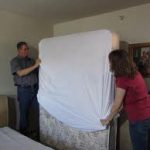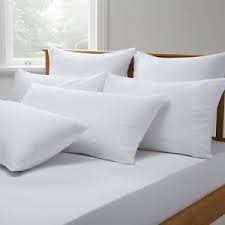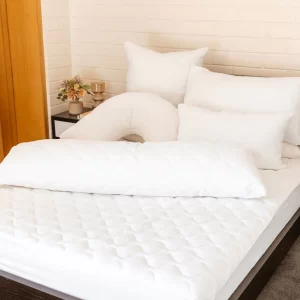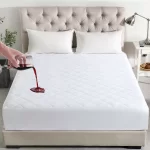How to Protect Your Bedding from Bed Bugs and Dust Mites
Your bed is meant to be a sanctuary – a place of rest, relaxation, and restoration. But for many Australians, unwanted intruders like bed bugs and dust mites can turn that peaceful space into a source of stress, allergies, and sleepless nights. Fortunately, there are practical, effective ways to protect your bedding and reclaim your comfort. In this guide, we’ll walk you through everything you need to know to defend your bed from these persistent pests.
Understanding the Threat
Before diving into protection strategies, it’s important to understand what you’re up against.
What Are Bed Bugs?

Bed bugs are small, reddish-brown insects that feed on human blood, typically while we’re asleep. Though they don’t transmit diseases, their bites can cause itching, allergic reactions, and psychological distress. Bed bugs are expert hiders and can live in mattress seams, bed frames, furniture, and even behind wallpaper.
What Are Dust Mites?
Dust mites, on the other hand, are microscopic creatures that thrive in warm, humid environments – especially in bedding, mattresses, and upholstered furniture. Unlike bed bugs, dust mites don’t bite, but their waste and body parts are major triggers for asthma, eczema, and allergies
Click to Read article on dust mites

Signs of Infestation
Bed Bug Infestation Signs:
- Small blood stains on your sheets or pillowcases
- Rust-coloured spots from their droppings
- A musty odour from the bugs’ scent glands
- Shed skins or eggshells
- Bite marks in clusters or lines, often on exposed skin
Dust Mite Allergies Signs:
- Sneezing, runny or stuffy nose
- Itchy, watery eyes
- Coughing or wheezing
- Skin rashes or flare-ups of eczema
- Symptoms that worsen at night or early morning
1. Invest in High-Quality Bedding Protectors
One of the most effective ways to safeguard against both bed bugs and dust mites is by using specialised bedding protectors.
Mattress Encasements

A mattress encasement fully seals your mattress in a tightly woven, zippered cover. Look for a protector that is:
- Bed bug-proof (lab-tested with a bite-proof, zip-lock seal)
- Dust mite-proof (with fabric pore sizes less than 10 microns)
- Waterproof and breathable for extra protection and comfort
- Easy to clean and machine washable
Once installed, bed bugs already in the mattress can’t escape to feed, and new ones can’t get in. Similarly, dust mites can no longer colonise your mattress or affect your health.
Click link to cover and Protect website for mattress encasements
Pillow Protectors
Your pillow is also a hotspot for dust mites. Use waterproof, allergen-proof pillow protectors under your pillowcases. Choose covers that are soft, noiseless, and durable to maintain sleep comfort while blocking mites and moisture.
Encasements for Quilts and Toppers
Don’t forget quilt protectors and topper encasements. These are ideal for people with allergies and asthma, and can also help keep bed bugs from hiding in fluffy layers.
2. Wash Bedding Regularly at High Temperatures
Both dust mites and bed bugs can be killed with heat, so washing your bedding frequently is a must.
Washing Tips:
- Sheets, pillowcases, and blankets: Wash weekly in hot water (at least 60°C)
- Pillows and quilts: Wash every 3–6 months (if washable) or use protectors that are washed monthly
- Dry on the hottest setting your fabric allows, or hang out under the strong Aussie sun for natural UV sterilisation
Steam ironing sheets or airing bedding on hot days can also help reduce mite populations.
3. Vacuum Your Mattress and Bedroom Frequently
Dust mites love dust and dander, while bed bugs can hide in cracks and under furniture. Keep your bedroom clean with regular vacuuming.
Click link to Cover and Protect dust mite vacuum cleaner
Vacuuming Tips:
- Use a HEPA-filter vacuum to trap allergens
- Vacuum your mattress, bed frame, skirting boards, and under the bed at least weekly
- Focus on seams, tufts, and cracks where bed bugs might hide
- Empty the vacuum bag or canister immediately outside to prevent re-infestation
Some vacuums even come with UV light attachments for extra mite-killing power.
4. Reduce Humidity in the Bedroom
Dust mites thrive in humid environments – ideally around 70–80% humidity. In Australia’s warmer, humid regions, this can be a big issue.
Ways to Control Humidity:
- Use a dehumidifier or air conditioner to keep humidity under 50%
- Open windows during dry days to let fresh air circulate
- Avoid drying clothes inside the bedroom
- Use moisture-absorbing materials like silica gel or charcoal bags
Lower humidity levels make your bedroom much less inviting for mites.
5. Declutter and Minimise Hiding Spots
Bed bugs love hiding in cluttered spaces. The more stuff you have around your bed, the more places they can sneak into.
Decluttering Tips:
- Keep your floor clear – avoid under-bed storage, especially with fabric containers
- Limit plush toys, cushions, and decorative bedding
- Store off-season clothes in sealed, airtight bags
- Consider minimal furniture and open frames that are easier to inspect and clean
6. Be Vigilant When Travelling or Moving
Bed bugs are world travellers and excellent hitchhikers. They can come into your home via:
- Suitcases from hotel stays
- Second-hand furniture or mattresses
- Guests bringing in infested bags or clothing
Preventative Tips:
- Inspect hotel bedding before sleeping – lift sheets and check mattress seams
- Keep suitcases off the floor and on hard surfaces or luggage racks
- Wash all clothes in hot water after travel
- Never bring home a used mattress or bed frame without thorough inspection
7. Use Safe Bed Bug Treatments if Needed
If you suspect a bed bug problem, act fast. Early intervention can stop a small issue from becoming a full-blown infestation.
Natural and Chemical Options:
- Diatomaceous Earth: A natural, non-toxic powder that kills bed bugs by drying them out. Safe for homes with pets and kids.
- Steam Treatment: Kills bugs and eggs on contact. Great for mattresses, carpets, and upholstery.
- Professional Pest Control: If the infestation is significant, call in licensed pest controllers. Look for those who specialise in heat treatments or low-toxicity options.
Avoid using bug bombs or foggers without guidance – they can make bugs scatter deeper into hiding places.
8. Choose Hypoallergenic Bedding
Invest in hypoallergenic bedding materials that naturally resist dust mites and are easy to wash.
Good Options Include:
- Microfibre or tightly woven cotton: Smooth and less penetrable to mites
- Wool or bamboo quilts: Naturally hypoallergenic and breathable
- Latex pillows or mattresses: Resistant to dust mites and mould
Avoid feather pillows or down comforters if you’re allergy-prone, as they can trap dust and are harder to clean.
Final Thoughts: Prevention is Key
Protecting your bedding from bed bugs and dust mites doesn’t have to be complicated. With the right protective covers, cleaning habits, and awareness, you can create a sleep environment that’s clean, comfortable, and safe from pests.
Remember – prevention is always easier and cheaper than extermination. Start with encasements and regular hot washing, and stay alert to signs of trouble.
Your bed should be a haven, not a hideout for bugs and allergens. With a bit of effort and the right products, you can sleep soundly and wake up refreshed – not itchy.
Quick Checklist for a Bug-Free Bed:
✅ Use bed bug- and dust mite-proof mattress and pillow protectors
✅ Wash all bedding weekly in hot water (60°C+)
✅ Vacuum mattress and bedroom with a HEPA vacuum
✅ Control humidity with air-con or dehumidifiers
✅ Avoid clutter around the bed
✅ Inspect luggage and used furniture carefully
✅ Use safe treatments at the first sign of bugs
If you’re looking for high-quality, Australian-tested bedding protection, consider Cover and Protect. Our range of mattress, pillow, and quilt protectors are waterproof, allergen-proof, and designed to keep your bed safe from unwanted guests – bed bugs, dust mites, and everything in between.
Sleep well, knowing you’re protected.
Contact Us Today
Do you have questions about our products? We’re here to help! Whether you need guidance on the best protector for your needs or have inquiries about our offerings, our friendly team is happy to assist.
📞 Call us: 02 931 66654 (Mon-Fri) | 0408 113 089 (7 Days)
📩 Email us: sales@coverandprotect.com.au
At Cover & Protect, we’re more than just a bedding protection supplier—we’re your trusted partner in creating a safer, healthier, and more comfortable sleep environment. Shop our range today and experience the best in bedding protection!





